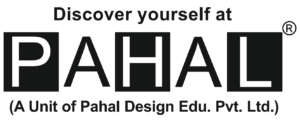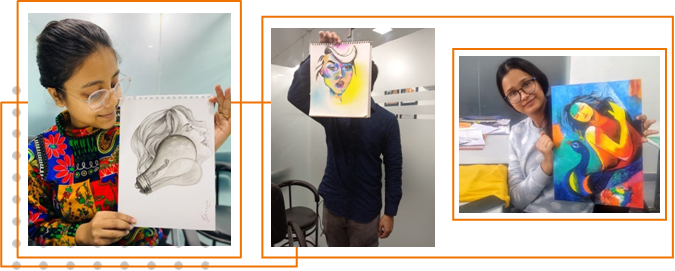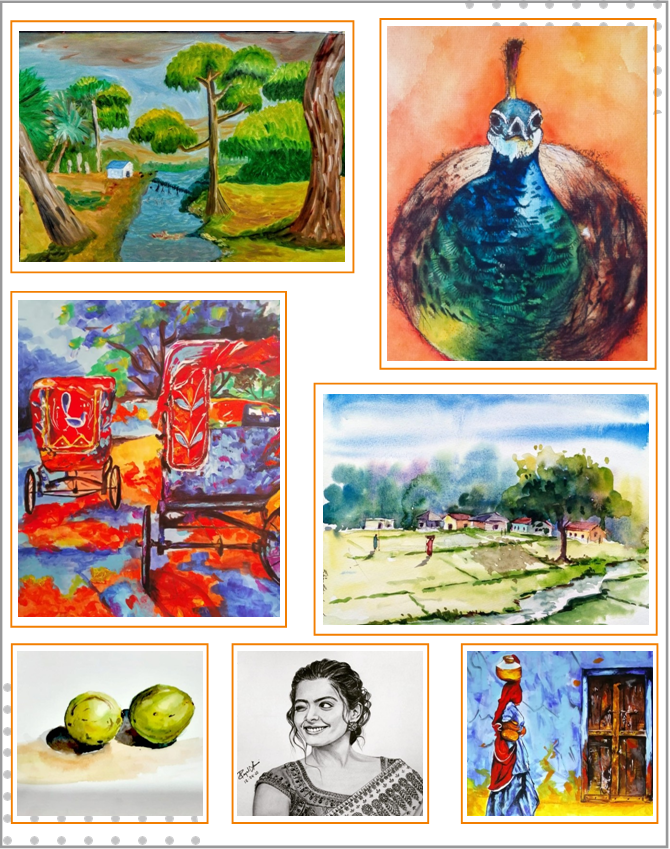Portfolio Preparation
About Creativity
Many people assume that creativity is an inborn talent that their kids either do or do not have: just as all children are not equally intelligent, all children are not equally creative. But actually, creativity is more skill than inborn talent and it is a skilled parent can help their kids develop. how children learn about the world.
It is a key to success in nearly everything we do, creativity is a key component of health and happiness and a core skill to practice with kids. Creativity is not limited to artistic and musical expression – it is also essential for science, math, and even social and emotional intelligence. Creative people are more flexible and better problem solvers, which makes them more able to adapt to technological advances and deal with change – as well as take advantage of new opportunities.
Creativity focuses on the process of forming original ideas through exploration and discovery. In children, creativity develops from their experiences with the process, rather than concern for the finished product. Creativity is not to be confused with talent, skill, or intelligence. Creativity is not about doing something better than others, it is about thinking, exploring, discovering, and imagining.
Research shows that children who draw frequently do better in reading and math and will shine at focusing on learning tasks. Choosing their own drawing materials empowers children and opens their eyes to the world around them. What can we do as teachers to help creativity take hold? When a child presents you with a drawing and says, “Look at what I made!”, respond by saying, “Tell me about your drawing,” or ask, “What do you like about your drawing?” These open-ended responses let the child evaluate his own creativity while initiating a conversation about the work at hand.
Einstein said, “Imagination is more important than knowledge.”Imagination is the door to possibilities. It is where creativity, ingenuity, and thinking outside the box begin for child development. Imaginative and creative play is
“If you have ideas but don’t act on them, you are imaginative but not creative.”
What is a Portfolio?
A portfolio is a compilation of materials that exemplifies your beliefs, skills qualifications, education, training, and experiences. It provides insight into your personality and work ethic. It is a visual record that demonstrates an understanding of basic art concepts, skilled use of materials, and the ability to communicate ideas visually with imagination, creativity, clarity, and originality. All in all, it is a representation of your professionalism.
Types of Portfolio Required in the Industry
Fashion Design Portfolio
Fashion Design portfolio preparation will help you to demonstrate flair, innovation, something different; through idea development, mood board design, fashion illustration, and a strong personal sense of design and style.
You will be able to build your portfolio exploring creative drawing skills, in a range of materials and mediums. Discover the figure, fabric, materials, and color. To be aware of innovative digital technologies in print and new fabrics. Experiment with mood board layout, surface, and presentation. Learn how to apply these skills to create mixed media sculptural fashion forms. Develop a sense for fashion accessorizing and detail, such as embroidery, textiles, weave, and print. Learn fashion illustration techniques and digital photography.
Industrial Design Porfolio
The Industrial Design portfolio preparation offers the learners to understand the various approaches, processes, and systems to address human needs by creating tangible products. In the various courses that the learners pursue, the emphasis is on learning-by-doing and following a comprehensive process of designing, producing, and marketing products, systems, and services.
The courses covered in the Program make the students understand concepts like design ethnography, design research, Ergonomics, Design Process, Strength of Materials, History of Design, sustainable design, and System Design.
Architectural Design portfolio
Architectural Design portfolios need to be innovative. Pahal Design motivates you to consider the aesthetic quality of what you design and make, whilst examining technical and environmental issues. You need to master design from conception to production and try to push conventional limits to design new products. You need to be a creative, independent thinker who can visualize in 3D, make a quick sketch become an idea; then make become a life-size reality and innovative design!
Fine Arts Portfolio

Fine Art Portfolio will allow you to discover the value of art in culture and society while exploring your personal direction. You need to develop your own critical understanding of a range of contemporary, historical, and international contexts. It is essential to have an awareness of historical and cultural development through time, in order to inspire your creative process. Equally, you need to demonstrate knowledge of the contemporary visual art world, concepts, and processes. Together this will increase your critical and contextual awareness of different perspectives and approaches within fine art. Pahal Design helps you to research and develop new ideas, concepts, and skills exploring a variety of mediums and materials.
Tips for a Great Portfolio
- Capture Attention- You will be tempted to overwhelm your prospect with your achievements. Resist this temptation. Your job is to capture Jury or the checker’s attention quickly and compellingly. Concentrate only on achieving a strong creative impact with more than 8 projects that showcase your best and most relevant work.
- Research about the college requirement- You need to make slightly different portfolios for each place you’re applying to. Certain designs, for example, may suit some Colleges but would get thrown out of another. Study the college requirement thoroughly, get to know little of their philosophy, and create something unique for them
- Content is the priority- Your portfolio’s presentation is just as important as its content. Even if you have the most amazing projects, an unattractive layout can cause your portfolio to be overlooked. Avoid over-cluttered pages and pay attention to your proportions.
- Compiling in PDF- Always bring a PDF version of your portfolio with you. Websites are great, but nothing beats a quick, searchable PDF!
- Display the work you want to get selected for Put your best project first. If someone only has 30 seconds to look at your portfolio, don’t you want to make sure they have the chance to see what you’ve got?
- Attention to the construction of it- Including too many drawings, and particularly, many technical drawings, can only hold your portfolio back; It takes up valuable space. It can be charming, however, to include a 1: 1 or 1: 2 detail that shows your attention to the construction and the precision of the design, but without exaggeration
- Identity on the cover page- Your name should be the most prominent element on your cover page, after all, it’s you that you want them to remember.
- Highlight the works- Utilize neutral backgrounds to really make your images pop. Don’t let over-designing detract from your work.
- Incorporate your personal branding- Consider your “brand.” Does your portfolio match your resume? Linked in profile? CV? Website? You are marketing yourself so make a consistent and compelling story.
- Quality, not Quantity- Make it short and sweet. Student portfolios shouldn’t be more than 26 pages maximum. Remember reviewers may only have 30 seconds to 1 minute to review your work. Pair it down to your best.
- Craft a narrative around your work- As a designer, your communication skills are just as paramount as the visuals you create. Humans are wired to connect with stories, which is why we always recommend crafting a narrative around your work. Don’t just show off the finished product! When showcasing projects, remember to explain the why behind your design decisions and what led you there. Aim to craft a story around each project to draw your visitors in.


Why Pahal Design?
- Develops Design Thinking
- Starts from Scratch(Basics)
- One to One interaction
- Discipline specific Portfolios
- Small Batch Size
- Variations with Different mediums
- Discussion of Theories of Design
Portfolio Preparation Program
In this course our faculty help student, how to think and made creatively work. students not only made here a very advanced portfolio also learned here how to think about a design aesthetically.
Portfolio Preparation For Design/ Architecture Colleges
Portfolio Preparation courses duration
| S.No. | Duration | Class |
| 1. | 12 Months | 96+ classes |
| 2. | 6 Months | 48+ classes |
| 3. | 4 Months | 40+ classes |
| 4. | 3 Months | 30+ classes |

Top colleges of Abroad
Choosing an overseas education during your university years is one of the most rewarding decisions you will ever make in your life. A study abroad experience will benefit you in ways beyond your imagination and expectations. It will offer you an opportunity to discover a unique diversified culture, make lifelong friendships and connections, and receive an education that goes a long way in your holistic development. Studying design and creative arts abroad gives you plenty of opportunities to create your own degree with a focus on your main interests. Within the creative field, international students can study anything from graphic design or art history to fashion management or performing arts.
Five Reasons to Study Abroad:
- Study abroad to explore a new culture.
- Become More Responsible While Studying in a Foreign Country.
- Build a Network of Friends from Around the World.
- Experience a different educational style.
- Stand Out to Future Employers with Your Academic Experience Abroad.
We’ve been in the industry for close to 22 years and know the best practices to help you realize your dream of studying abroad. Our range of services, experienced team, and foothold in the industry ensure that your international future is bright and rewarding.
What Pahal Design Do?
- Course Advice
- Visa Application assistance
- Free Study Abroad Counselling
- Scholarships information
- Admission Guidance
- Accommodation Assistance
- Portfolio Preparation
- Pre-Departure Support
- Strong IELTS/TOFEL
- Information Post Arrival
- Support Financial
- Estimation Interview
- Preparation
Top International Fashion and Design Colleges:
- Istituto Marangoni, Milan, Paris and London
- NAFA Singapore
- Parsons, New York USA
- FIT, New York, USA
- Rhode Island School of Design, USA
- Art Centre College of Design, USA
- Royal College of Art, UK
- Central Saint Martin’s College of Art and Design, UK
- London College of Fashion, UK
- University for the Creative Arts, UK
- Loughborough Design School, UK
- LASALLE College of the Arts, Singapore
- Domus Academy, Italy
- NABA, Italy
- Polimoda, Italy
- Accademia Costume and Moda, Italy
- ESMOD International, Paris
- Griffith University, Australia
- IED, Milan, Rome, Florence

ONLINE COUNSELING











































